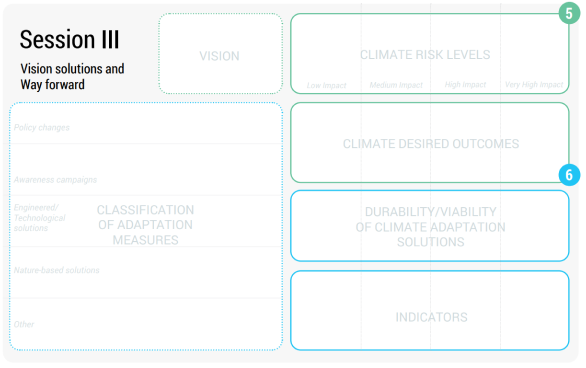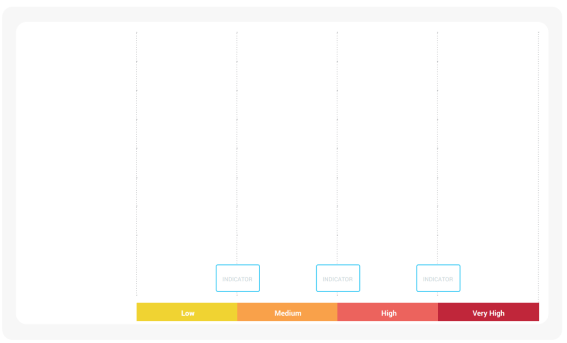
SESSION III
Vision, Solutions and Way Forward (Construction of adaptation Pathways)
Download playbook
During Session 3 we will explore the vision and adaptation pathways for the region, the different solutions and the way forward. The goal is to develop a vision for the desired future and align adaptation response measures with this vision.
Objectives
Session 2 identified the most prominent risk, the different risk levels, indicators and respective thresholds based on the knowledge of local stakeholders oftheir territory and presented scientific data on climate impacts.
- During Session 3 we will explore the vision and adaptation pathways for the region, the different solutions and the way forward.
- The goal is to develop a vision for the desired future and align adaptation response measures with this vision.
- The participants should be given an overview of the concepts of transformative adaptation, to understand the framework which will enable them to complete the exercises and transform their practices, instead of finding coping solutions.
- Once the vision is defined, the adaptive measures can be chosen from the different solution catalogue (policy changes, awareness campaigns, engineered / technological solutions, nature-based solutions, etc.) so we can emphasize and valorise the deliverable.
- The goal is to develop an adaptation pathways map specific for a sector, laying out solutions to address the most prominent risk.
Guidelines
- Based on the agenda / order of the day you can determine the different topics to work on in session 3. Present the results of session 2 to get the participants back on topic.
- Inform participants on the principles and interest of developing adaptation pathways.
- Given that the 3rd session is very strategic and vision driven you need to inspire the participants to think outside the box.
- To be well prepared for the 3rd session, it is important to present some solutions and ways forward to trigger the discussion
- To select corresponding solutions or measures, you may access the catalogue of solutions prepared by ACTERRA to be found in the TransformAr website.
- Solutions should be laid out based on priorities, risk levels, durability and feasibility of the solutions. When laying out the solutions, please consider critical thresholds.
Proposed agenda


Explain what adaptation pathways are
It is important to prepare some slides on adaptation pathways and perhaps some real life examples or analogous visual aids. It will help the participants grasp the concepts before moving onto the exercise. If you need extra input for this, you can consult the webpage about adaptation pathways or check the playbook.
Fill in the main canvas with the participants
Session III will use collected information from the previous sessions to select a number of promising climate adaptation solutions. The most prominent risk identified in Session II for a specific sector will be matched with a defined objective (desired outcome) for that impact level. A range of solutions, identified from the catalogue of solutions, will be classified by participants as “Great”, “Okay” or “Inappropriate” measures. This classification permits them to determine their preferences and their acceptability of the measures. In this context it is important to underline that some adaptation solutions work in a territory, but not in another one. Thus the importance of developing and implementing tailor-made solutions. Once the solutions are classified, the “good” climate adaptation solutions will be considered for the development of adaptation pathways. The solutions need to match the desired outcome, and should be placed in respect with determined risk levels.
The first step in this session is to develop a vision. You can do this with a moodboard, a poll, word storm games, etc. You can find an example of a poll in the playbook. If you are doing this workshop online, you can create a moodboard and post these images in the field ‘Vision’.
In the next step, you are going to copy the Climate Risk Levels from session II. Afterwards you will, together with the participant, define objectives and desired outcomes that align with their long-term vision for a better future.
The next step is filling in the Classification of Adaptation Solutions. You can do this by pre-populating this field with measures taken either from the catalogue of solutions or will allow the participants to propose their own. These will then be classified by colour (Green/Blue/Red) into better or worse measures. If working online this can be done by changing the colour of the sticky note in the chosen application, if working physically a coloured marker can be used.
Good (Green): This measure has the potential to transform the sector.
OK (Blue): This measure could be implemented when necessary.
Inappropriate (Red): Does not correspond to the challenges of the territory
Afterwards you will place the measures identified in the catalogue section into the appropriate column in the ‘Durability/Viability of Climate Adaptation Solutions’ - field so that it aligns with the desired outcome and corresponding risk level. By mapping different measures across the risk level impacts, we can start building the first steps towards an adaptation pathway for that particular risk.
The last step of this group exercise is to write down indicators. Indicators are determined through discussions between scientists and local stakeholders. For instance, if local stakeholders believe that soil erosion in light of climate change is a critical concern, it is important to understand what this risk leads to, to determine the right indicator. Concretely, if soil erosion impacts crop productivity, the latter could be a good indicator. Yet, it is essential to ask questions like: how do we monitor ? Do we have the data? Do we consider annual cropbased income as an indicator for crop productivity? Other indicators could also be considered.
You can find an example for this session in the playbook.

Fill in the conclusion canvas
After the second session is finalised the organiser can create a conclusion canvas that summarises all risk components per sector. The canvas allows to present a summary of the results, and to kick off the following session.
You can find an example in the playbook.

